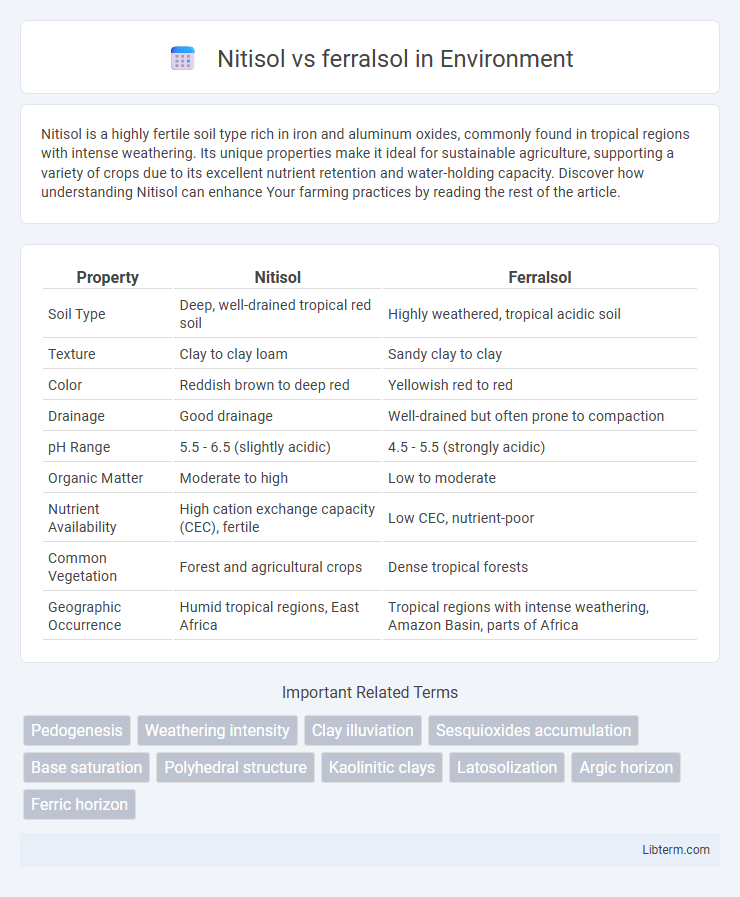Nitisol is a highly fertile soil type rich in iron and aluminum oxides, commonly found in tropical regions with intense weathering. Its unique properties make it ideal for sustainable agriculture, supporting a variety of crops due to its excellent nutrient retention and water-holding capacity. Discover how understanding Nitisol can enhance Your farming practices by reading the rest of the article.
Table of Comparison
| Property | Nitisol | Ferralsol |
|---|---|---|
| Soil Type | Deep, well-drained tropical red soil | Highly weathered, tropical acidic soil |
| Texture | Clay to clay loam | Sandy clay to clay |
| Color | Reddish brown to deep red | Yellowish red to red |
| Drainage | Good drainage | Well-drained but often prone to compaction |
| pH Range | 5.5 - 6.5 (slightly acidic) | 4.5 - 5.5 (strongly acidic) |
| Organic Matter | Moderate to high | Low to moderate |
| Nutrient Availability | High cation exchange capacity (CEC), fertile | Low CEC, nutrient-poor |
| Common Vegetation | Forest and agricultural crops | Dense tropical forests |
| Geographic Occurrence | Humid tropical regions, East Africa | Tropical regions with intense weathering, Amazon Basin, parts of Africa |
Introduction to Nitisols and Ferralsols
Nitisols are deep, well-drained tropical soils characterized by a high clay content with a unique blocky structure and significant iron and aluminum oxides, making them highly fertile and suitable for agriculture. Ferralsols are intensely weathered soils found predominantly in tropical regions, marked by a low nutrient status, high acidity, and dominance of kaolinite clay and iron oxides, resulting in poor fertility. Both soil types reflect advanced tropical soil development but differ significantly in their physical properties and agricultural potential.
Formation and Geographic Distribution
Nitisols form predominantly in humid tropical regions, developing from deep weathering of basaltic parent material leading to well-structured, clay-rich soils with high porosity. Ferralsols emerge in old, deeply weathered landscapes of tropical rainforests, characterized by high iron and aluminum oxide content resulting in reddish, sandy, and highly weathered soils. Nitisols are widespread in East African highlands, while Ferralsols dominate the Amazon Basin, Central Africa, and Southeast Asia.
Key Physical Characteristics
Nitisols are characterized by deep, well-drained profiles with a moderate to high clay content and a blocky structure that enhances water retention and root penetration. Ferralsols exhibit a highly weathered, acidic nature with a sandy to loamy texture, low nutrient content, and a coarse, granular structure that promotes good drainage but poor water and nutrient retention. Both soils differ significantly in color, with Nitisols typically showing reddish hues due to iron oxide presence, while Ferralsols often appear yellowish to reddish, reflecting their intense weathering status.
Chemical Properties Comparison
Nitisols exhibit higher cation exchange capacity (CEC) and greater base saturation compared to Ferralsols, reflecting their improved nutrient retention and availability. Ferralsols are characterized by extremely low pH values and high iron and aluminum oxide content, leading to strong acidity and limited fertility. The elevated organic matter content in Nitisols contributes to enhanced chemical properties, whereas Ferralsols often require liming and fertilization to correct their pronounced chemical deficiencies.
Soil Fertility and Productivity
Nitisols exhibit moderate to high soil fertility due to their well-structured clay-enriched subsurface horizons, promoting nutrient retention and optimal root growth, which enhances agricultural productivity. In contrast, Ferralsols are highly weathered and acidic with low natural fertility, characterized by low cation exchange capacity (CEC) and limited availability of essential nutrients such as phosphorus. Effective management practices including liming and organic amendments are essential to improve fertility and productivity in Ferralsols compared to the inherently more fertile Nitisols.
Typical Vegetation and Land Use
Nitisols support dense tropical forests and are frequently used for intensive agriculture such as coffee, tea, and bananas due to their good drainage and moderate fertility. Ferralsols typically sustain open woodland and savanna vegetation, with land use primarily centered around extensive grazing and low-intensity cropping because of their highly weathered, acidic, and nutrient-poor characteristics. Both soils play crucial roles in tropical and subtropical land management, but their vegetation and land use suitability differ markedly based on soil properties.
Management Practices for Nitisols
Effective management practices for Nitisols emphasize maintaining organic matter through regular addition of compost or green manure to improve soil fertility and structure. Implementing contour plowing and terracing helps prevent erosion due to the soil's susceptibility on sloped terrains. Crop rotation with legumes enhances nitrogen fixation, reducing dependency on synthetic fertilizers and promoting sustainable agricultural productivity.
Management Practices for Ferralsols
Management practices for Ferralsols emphasize maintaining soil fertility through the use of organic matter such as compost and green manure to enhance nutrient retention and structure. These highly weathered soils with low natural fertility require careful pH management and the application of lime and phosphorus fertilizers to improve crop productivity. Compared to Nitisols, Ferralsols benefit significantly from conservation agriculture techniques including minimal tillage and cover cropping to prevent erosion and maintain soil health.
Challenges and Limitations of Each Soil
Nitisol soils, while highly fertile and well-structured, face challenges such as susceptibility to erosion on steep slopes and nutrient depletion from intensive farming. Ferralsol soils exhibit limitations including low natural fertility, high acidity, and poor nutrient retention due to intense weathering and leaching in tropical climates. Both soils require tailored management practices, with Nitisols needing erosion control and balanced fertilization, and Ferralsols demanding liming and organic amendments to improve soil productivity.
Sustainable Strategies for Nitisol and Ferralsol Use
Sustainable strategies for Nitisol and Ferralsol emphasize integrated soil fertility management, including the use of organic amendments to enhance nutrient retention and soil structure in these highly weathered tropical soils. Conservation agriculture practices, such as minimum tillage and cover cropping, improve water retention and reduce erosion, crucial for maintaining long-term productivity on Nitisol and Ferralsol landscapes. Tailored nutrient management, incorporating site-specific fertilizer recommendations based on soil testing, optimizes crop yields while minimizing environmental impacts on these nutrient-poor soils.
Nitisol Infographic

 libterm.com
libterm.com